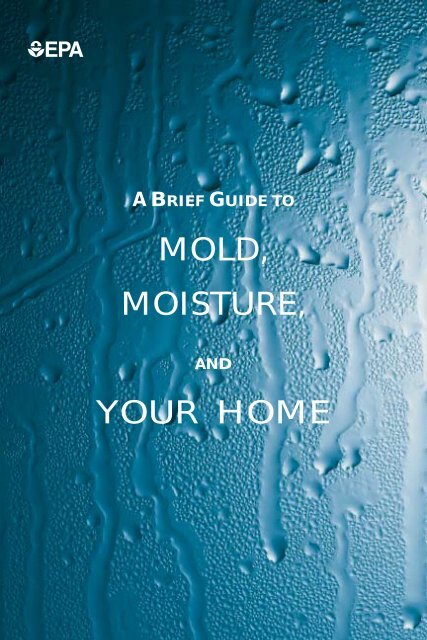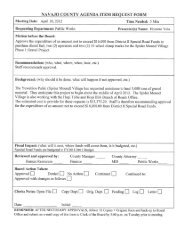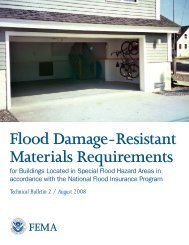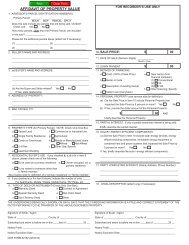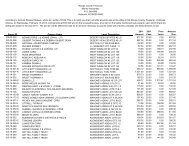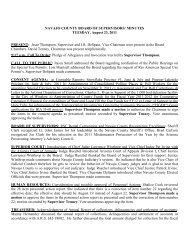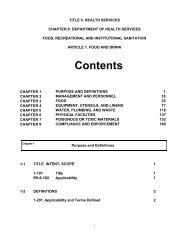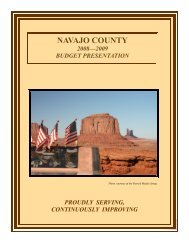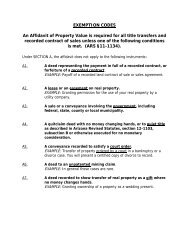MOLD, MOISTURE, YOUR HOME - Navajo County
MOLD, MOISTURE, YOUR HOME - Navajo County
MOLD, MOISTURE, YOUR HOME - Navajo County
Create successful ePaper yourself
Turn your PDF publications into a flip-book with our unique Google optimized e-Paper software.
A BRIEF GUIDE TO<br />
<strong>MOLD</strong>,<br />
<strong>MOISTURE</strong>,<br />
AND<br />
<strong>YOUR</strong> <strong>HOME</strong>
EPA 402-K-02-003<br />
This Guide provides<br />
information and guidance<br />
for homeowners and<br />
renters on how to clean<br />
up residential mold<br />
problems and how to<br />
prevent mold growth.<br />
U.S. Environmental Protection Agency<br />
Office of Air and Radiation<br />
Indoor Environments Division<br />
1200 Pennsylvania Avenue<br />
Mailcode: 6609J<br />
Washington, DC 20460<br />
www.epa.gov/iaq
A BRIEF GUIDE TO <strong>MOLD</strong>,<br />
<strong>MOISTURE</strong>, AND <strong>YOUR</strong> <strong>HOME</strong><br />
Contents<br />
Page<br />
Mold Basics<br />
Why is mold growing in my home 2<br />
Can mold cause health problems 2<br />
How do I get rid of mold 3<br />
Mold Cleanup<br />
Who should do the cleanup 4<br />
Mold Cleanup Guidelines 6<br />
What to Wear When Cleaning Moldy Areas 8<br />
How Do I Know When the Remediation<br />
or Cleanup is Finished 9<br />
Moisture and Mold Prevention and Control Tips 10<br />
Actions that will help to reduce humidity 11<br />
Actions that will help prevent condensation 12<br />
Testing or sampling for mold 13<br />
Hidden Mold 14<br />
Cleanup and Biocides 15<br />
Additional Resources 16<br />
1
<strong>MOLD</strong> BASICS<br />
W<br />
■ The key to mold control is moisture control.<br />
■ If mold is a problem in your home, you should clean up<br />
the mold promptly and fix the water problem.<br />
■ It is important to dry water-damaged areas and items<br />
within 24-48 hours to prevent mold growth.<br />
hy is mold growing in my home Molds are part of the<br />
natural environment. Outdoors, molds play a<br />
part in nature by breaking down dead organic<br />
matter such as fallen leaves and dead trees, but<br />
indoors, mold growth should be avoided. Molds<br />
reproduce by means of tiny spores; the spores<br />
are invisible to the naked eye and float through<br />
outdoor and indoor air. Mold may begin growing<br />
Mold growing outdoors on<br />
firewood. Molds come in<br />
many colors; both white and<br />
black molds are shown here.<br />
indoors when mold spores land on surfaces that<br />
are wet. There are many types of mold, and none<br />
of them will grow without water or moisture.<br />
Can mold cause health problems Molds are usually not a<br />
problem indoors, unless mold spores land on a wet or<br />
damp spot and begin growing. Molds have the potential to<br />
cause health problems. Molds produce allergens<br />
(substances that can cause allergic reactions), irritants, and<br />
in some cases, potentially toxic substances (mycotoxins).<br />
Inhaling or touching mold or mold spores may cause<br />
allergic reactions in sensitive individuals. Allergic responses<br />
include hay fever-type symptoms, such as sneezing, runny<br />
nose, red eyes, and skin rash (dermatitis). Allergic reactions<br />
to mold are common. They can be immediate or delayed.<br />
Molds can also cause asthma attacks in people with asthma<br />
who are allergic to mold. In addition, mold exposure can<br />
irritate the eyes, skin, nose, throat, and lungs of both mold-<br />
2
allergic and non-allergic people. Symptoms other than<br />
the allergic and irritant types are not commonly<br />
reported as a result of inhaling mold.<br />
Research on mold and health effects is ongoing. This<br />
brochure provides a brief overview; it does not describe<br />
all potential health effects related to mold exposure. For<br />
more detailed information consult a health<br />
professional. You may also wish to consult your state or<br />
local health department.<br />
How do I get rid of mold It is impossible to get rid of<br />
all mold and mold spores indoors; some mold spores<br />
will be found floating through the air and in house dust.<br />
The mold spores will not grow if moisture is not<br />
present. Indoor mold growth can and should be<br />
prevented or controlled by controlling moisture<br />
indoors. If there is mold growth in your home, you<br />
must clean up the mold and fix the water problem. If<br />
you clean up the mold, but don’t fix the water problem,<br />
then, most likely, the mold problem will come back.<br />
Magnified mold spores.<br />
Molds can gradually<br />
destroy the things<br />
they grow on. You can<br />
prevent damage to<br />
your home and<br />
furnishings, save<br />
money, and avoid<br />
potential health<br />
problems by<br />
controlling moisture<br />
and eliminating mold<br />
growth.<br />
3
<strong>MOLD</strong><br />
CLEANUP<br />
Leaky window – mold is beginning to<br />
rot the wooden frame and windowsill.<br />
If you already have a<br />
mold problem –<br />
ACT QUICKLY.<br />
Mold damages what it<br />
grows on. The longer<br />
it grows, the more<br />
damage it can cause.<br />
Who should do the cleanup Who should do the cleanup<br />
depends on a number of factors. One consideration is the<br />
size of the mold problem. If the moldy area is less than<br />
about 10 square feet (less than roughly a 3 ft. by 3 ft. patch),<br />
in most cases, you can handle the job yourself, following the<br />
guidelines below. However:<br />
■ If there has been a lot of water damage, and/or mold<br />
growth covers more than 10 square feet, consult the U.S.<br />
Environmental Protection Agency (EPA) guide: Mold<br />
Remediation in Schools and Commercial Buildings.<br />
Although focused on schools and commercial<br />
4
uildings, this document is applicable to other<br />
building types. It is available free by calling the EPA<br />
Indoor Air Quality Information Clearinghouse at<br />
(800) 438-4318, or on the Internet at:<br />
www.epa.gov/iaq/molds/mold_remediation.html.<br />
■ If you choose to hire a contractor (or other professional<br />
service provider) to do the cleanup, make sure the<br />
contractor has experience cleaning up mold. Check<br />
references and ask the contractor to follow the<br />
recommendations in EPA’s Mold Remediation in Schools<br />
and Commercial Buildings, the guidelines of the American<br />
Conference of Governmental Industrial Hygenists<br />
(ACGIH), or other guidelines from professional or<br />
government organizations.<br />
■ If you suspect that the heating/ventilation/air<br />
conditioning (HVAC) system may be contaminated with<br />
mold (it is part of an identified moisture problem, for<br />
instance, or there is mold near the intake to the system),<br />
consult EPA’s guide Should You Have the Air Ducts in Your<br />
Home Cleaned before taking further action. Do not run<br />
the HVAC system if you know or suspect that it is<br />
contaminated with mold - it could spread mold<br />
throughout the building. Visit www.epa.gov/iaq/pubs/<br />
airduct.html, or call (800) 438-4318 for a free copy.<br />
■ If the water and/or mold damage was caused by sewage<br />
or other contaminated water, then call in<br />
a professional who has experience cleaning and fixing<br />
buildings damaged by contaminated water.<br />
■ If you have health concerns, consult a health professional<br />
before starting cleanup.<br />
5
<strong>MOLD</strong> CLEANUP GUIDELINES<br />
Bathroom Tip<br />
Places that<br />
are often or<br />
always damp can be hard to maintain completely<br />
free of mold. If there’s some mold in the shower or<br />
elsewhere in the bathroom that seems to reappear,<br />
increasing the ventilation (running a fan or opening<br />
a window) and cleaning more frequently will usually<br />
prevent mold from recurring, or at least keep the<br />
mold to a minimum.<br />
Tips and techniques The tips and techniques presented in this<br />
section will help you clean up your mold problem.<br />
Professional cleaners or remediators may use<br />
methods not covered in this publication. Please note<br />
that mold may cause staining and cosmetic damage. It<br />
may not be possible to clean an item so that its<br />
original appearance is restored.<br />
■ Fix plumbing leaks and other water problems as<br />
soon as possible. Dry all items completely.<br />
■ Scrub mold off hard surfaces with detergent and water,<br />
and dry completely.<br />
Mold<br />
growing<br />
on the<br />
underside<br />
of a plastic<br />
lawnchair<br />
in an area<br />
where<br />
rainwater<br />
drips through<br />
and deposits<br />
organic<br />
material.<br />
6
Mold growing<br />
on a piece of<br />
ceiling tile.<br />
■ Absorbent or porous materials, such as ceiling tiles and<br />
carpet, may have to be thrown away if they become<br />
moldy. Mold can grow on or fill in the empty spaces and<br />
crevices of porous materials, so the mold may be<br />
difficult or impossible to remove completely.<br />
■ Avoid exposing yourself or others to mold (see<br />
discussions: What to Wear When Cleaning Moldy Areas<br />
and Hidden Mold.)<br />
■ Do not paint or caulk moldy surfaces. Clean up the<br />
mold and dry the surfaces before painting. Paint applied<br />
over moldy surfaces is likely to peel.<br />
■ If you are unsure about how to clean an item, or if the<br />
item is expensive or of sentimental value, you may wish<br />
to consult a specialist. Specialists in furniture repair,<br />
restoration, painting, art restoration and conservation,<br />
carpet and rug cleaning, water damage, and fire or water<br />
restoration are commonly listed in phone books. Be<br />
sure to ask for and check references. Look for specialists<br />
who are affiliated with professional organizations.<br />
7
WHAT TO WEAR WHEN<br />
CLEANING<br />
<strong>MOLD</strong>Y AREAS<br />
Mold growing on a suitcase stored in a<br />
humid basement.<br />
It is important<br />
to take<br />
precautions to<br />
LIMIT<br />
<strong>YOUR</strong><br />
EXPOSURE<br />
to mold and<br />
mold spores.<br />
■ Avoid breathing in mold or mold spores. In order<br />
to limit your exposure to airborne mold, you may want to<br />
wear an N-95 respirator, available at many hardware<br />
stores and from companies that advertise on the<br />
Internet. (They cost about $12 to $25.) Some N-95<br />
respirators resemble a paper dust mask with<br />
a nozzle on the front, others are made primarily<br />
of plastic or rubber and have removable cartridges that<br />
trap most of the mold spores from entering.<br />
In order to be effective, the respirator or mask<br />
must fit properly, so carefully follow the instructions<br />
supplied with the respirator. Please note that the<br />
Occupational Safety and Health Administration (OSHA)<br />
requires that respirators fit properly (fit testing) when<br />
used in an occupational setting; consult OSHA for more<br />
information (800-321-OSHA or osha.gov/).<br />
8
■ Wear gloves. Long gloves that extend to the middle of<br />
the forearm are recommended. When working with water<br />
and a mild detergent, ordinary household rubber gloves<br />
may be used. If you are using a disinfectant, a biocide<br />
such as chlorine bleach, or a strong cleaning solution,<br />
you should select gloves made from natural rubber,<br />
neoprene, nitrile, polyurethane, or PVC (see Cleanup<br />
and Biocides). Avoid<br />
touching mold or moldy<br />
items with your bare hands.<br />
■ Wear goggles. Goggles<br />
that do not have<br />
ventilation holes are<br />
recommended.<br />
Avoid getting mold or<br />
mold spores in your eyes.<br />
Cleaning while wearing N-95<br />
respirator, gloves, and goggles.<br />
How do I know when the remediation or cleanup<br />
is finished You must have completely fixed the<br />
water or moisture problem before the cleanup or<br />
remediation can be considered finished.<br />
■ You should have completed mold removal. Visible mold<br />
and moldy odors should not be present. Please note that<br />
mold may cause staining and cosmetic damage.<br />
■ You should have revisited the site(s) shortly after<br />
cleanup and it should show no signs of water damage<br />
or mold growth.<br />
■ People should have been able to occupy or re-occupy the<br />
area without health complaints or physical symptoms.<br />
■ Ultimately, this is a judgment call; there is no easy<br />
answer. If you have concerns or questions call the<br />
EPA Indoor Air Quality Information Clearinghouse<br />
at (800) 438-4318.<br />
9
<strong>MOISTURE</strong> AND <strong>MOLD</strong><br />
PREVENTION AND<br />
CONTROL TIPS<br />
Moisture<br />
Control is the Key to<br />
Mold Control<br />
Mold growing<br />
on the surface<br />
of a unit<br />
ventilator.<br />
■ Clean and repair roof gutters regularly.<br />
■ When water leaks or spills occur<br />
indoors - ACT QUICKLY.<br />
If wet or damp materials or areas<br />
are dried 24-48 hours after a leak<br />
or spill happens, in most cases<br />
mold will not grow.<br />
■ Make sure the ground slopes away from the building<br />
foundation, so that water does not enter or collect<br />
around the foundation.<br />
■ Keep air conditioning drip pans clean and the drain<br />
lines unobstructed and flowing properly.<br />
10
Condensation on the inside of a<br />
windowpane.<br />
■ Keep indoor humidity low. If<br />
possible, keep indoor<br />
humidity below 60 percent<br />
(ideally between 30 and 50<br />
percent) relative humidity.<br />
Relative humidity can be<br />
measured with a moisture or<br />
humidity meter, a small,<br />
inexpensive ($10-$50)<br />
instrument available at many<br />
hardware stores.<br />
■ If you see condensation or moisture collecting on<br />
windows, walls or pipes - ACT QUICKLY to dry the<br />
wet surface and reduce the moisture/water source.<br />
Condensation can be a sign of high humidity.<br />
Actions that will help to reduce humidity:<br />
Vent appliances that produce moisture, such as<br />
clothes dryers, stoves, and kerosene heaters to the<br />
outside where possible. (Combustion appliances<br />
such as stoves and kerosene heaters produce water<br />
vapor and will increase the humidity unless vented<br />
to the outside.)<br />
Use air conditioners and/or de-humidifiers<br />
when needed.<br />
Run the bathroom fan or open the window when<br />
showering. Use exhaust fans or open windows<br />
whenever cooking, running the dishwasher or<br />
dishwashing, etc.<br />
11
Actions that will help prevent condensation:<br />
Reduce the humidity (see preceeding page).<br />
Increase ventilation or air movement by opening doors<br />
and/or windows, when practical. Use fans as needed.<br />
Cover cold surfaces, such as cold water pipes, with<br />
insulation.<br />
Increase air temperature.<br />
Mold<br />
growing<br />
on a<br />
wooden<br />
headboard<br />
in a room<br />
with high<br />
humidity.<br />
12
Renters: Report all plumbing leaks and moisture problems<br />
immediately to your building owner, manager, or<br />
superintendent. In cases where persistent water<br />
problems are not addressed, you may want to contact<br />
local, state, or federal health or<br />
housing authorities.<br />
Testing or sampling for<br />
mold Is sampling for mold<br />
needed In most cases, if visible<br />
mold growth is present, sampling<br />
is unnecessary. Since no EPA or<br />
other federal limits have been set<br />
for mold or mold spores, sampling<br />
cannot be used to check a<br />
building’s compliance with federal<br />
mold standards. Surface sampling<br />
may be useful to determine if an<br />
area has been adequately cleaned or remediated. Sampling<br />
for mold should be conducted by professionals who have<br />
specific experience in designing mold sampling protocols,<br />
sampling methods, and interpreting results. Sample<br />
analysis should follow analytical methods recommended by<br />
the American Industrial Hygiene Association (AIHA), the<br />
American Conference of Governmental Industrial Hygienists<br />
(ACGIH), or other professional organizations.<br />
Rust is an indicator that condensation<br />
occurs on this drainpipe. The pipe should<br />
be insulated to prevent condensation.<br />
13
HIDDEN <strong>MOLD</strong><br />
Mold growing<br />
on the back<br />
side of<br />
wallpaper.<br />
Suspicion of hidden mold You may suspect hidden mold if a<br />
building smells moldy, but you cannot see the source,<br />
or if you know there has been water damage and residents<br />
are reporting health problems. Mold may be hidden in<br />
places such as the back side of dry wall, wallpaper, or<br />
paneling, the top side of ceiling tiles, the underside of<br />
carpets and pads, etc. Other possible locations of<br />
hidden mold include areas inside walls around pipes<br />
(with leaking or condensing pipes), the surface of walls<br />
behind furniture (where condensation forms), inside<br />
ductwork, and in roof materials above ceiling tiles (due<br />
to roof leaks or insufficient insulation).<br />
Investigating hidden mold problems Investigating hidden mold<br />
problems may be difficult and will require caution when the<br />
investigation involves disturbing potential sites of mold<br />
growth. For example, removal of wallpaper can lead to a<br />
massive release of spores if there is mold growing on the<br />
underside of the paper. If you believe that you may have a<br />
hidden mold problem, consider hiring an experienced<br />
professional.<br />
14
Cleanup and Biocides Biocides are substances that can destroy living<br />
organisms. The use of a chemical or biocide that kills<br />
organisms such as mold (chlorine bleach, for example) is<br />
not recommended as a routine practice during mold<br />
cleanup. There may be instances, however, when<br />
professional judgment may indicate its use (for example,<br />
when immune-compromised individuals are present). In<br />
most cases, it is not possible or desirable to sterilize an<br />
area; a background level of mold spores will remain - these<br />
spores will not grow if the moisture problem has been<br />
resolved. If you choose to use disinfectants or biocides,<br />
always ventilate the area and exhaust the air to the<br />
outdoors. Never mix chlorine bleach solution with other<br />
cleaning solutions or detergents that contain ammonia<br />
because toxic fumes could be produced.<br />
Please note: Dead mold may still cause allergic reactions in some<br />
people, so it is not enough to simply kill the mold, it must<br />
also be removed.<br />
Water stain<br />
on a basement<br />
wall — locate<br />
and fix the<br />
source of the<br />
water promptly.<br />
15
ADDITIONAL RESOURCES<br />
For more information on mold related issues including<br />
mold cleanup and moisture control/condensation/humidity<br />
issues, you can call the EPA Indoor Air Quality Information<br />
Clearinghouse at<br />
(800) 438-4318.<br />
Or visit:<br />
www.epa.gov/iaq/molds<br />
Mold growing on fallen leaves..<br />
This document is available on the Environmental Protection Agency, Indoor<br />
Environments Division website at: www.epa.gov/iaq/molds/moldguide.html<br />
16
NOTES<br />
Acknowledgements<br />
EPA would like to thank Paul Ellringer, PE, CIH, for providing the photo on page 14.<br />
Please note that this document presents recommendations. EPA does not regulate<br />
mold or mold spores in indoor air.


